How to Get Better at Golf Without Lessons – 16 Top Tips
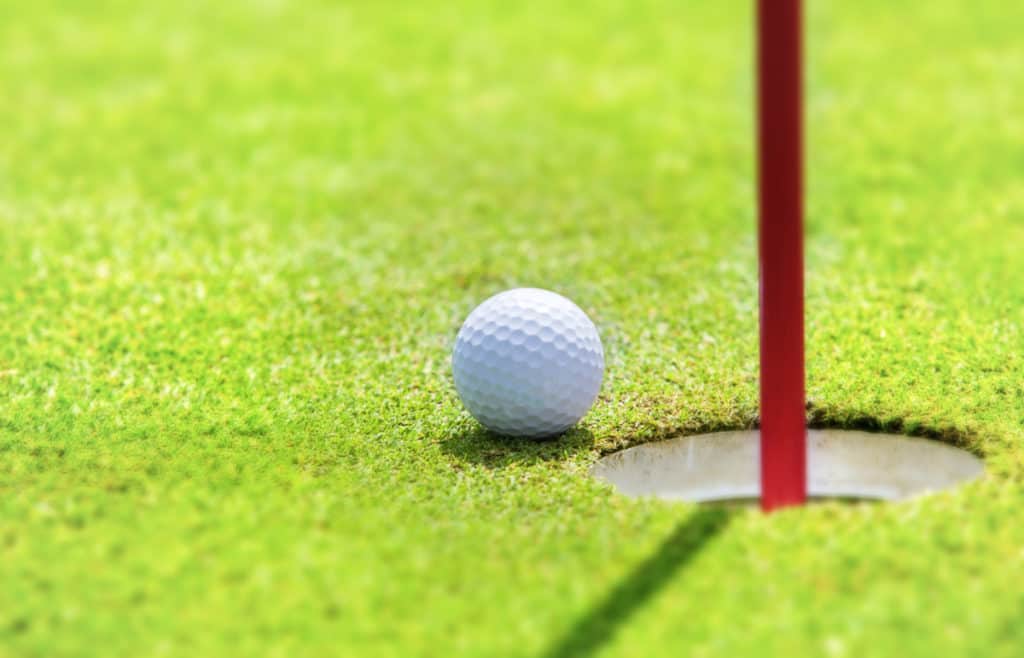
Golf lessons are often cited as one of the best ways to improve your game.
It is not often you will find someone advising a new or even long term golfer that they do not need to bother with lessons.
But it is not compulsory for any golfer to take lessons and indeed only 15% of golfers seeks professional instruction.
There are also a number of examples, including two-time Masters Champion Bubba Watson, of players who have never had a lesson and clearly have done just fine.
Golf lessons also cost money and if you take a few the amount you spend can add up.
So to help players who do not want to spend alot of money on golf lessons, or indeed do not have a lot of time to fit them into their busy schedule, I’ve put together a list of 16 of the best ways to get better at golf without taking lessons.
Not all these will apply to all standards of golfer but if you are looking to improve your game without taking a lesson you will find something useful on here.
Expect the Unexpected. Work on Changing Your Mental Approach
You do not need to tell any golfer who has played the game for any length of time that it can play havoc with the mind.
Golf is hard and arguably the hardest sport mentally for players to play.
Not only does every shot count without exception but the scoring system, which sets a ‘scoring par’ on each hole, means that the average golfer has to face up to having ‘failed’ on almost every hole.
Golfers also face the unique concentration challenge of having to ‘play’ for only a tiny fraction of the time they are on the course – players will only spend a few minutes over a 2½ -4 hour round actually hitting the ball.
Add to this a complex and un-natural series of movements that need to be combined together and timed well repeatedly within the golf swing and it easy to see how golfers can easily lose focus and get quickly frustrated.
“Golf is played mainly on a five-and-a-half inch course … the space between your ears … No-one ever had golf under his thumb. No round will ever be so good it could not have been better. Perhaps this is why golf is the greatest of games.“
Bobby Jones, 7 Time Major Champion.
But if you can reset your mental approach and start to work on accepting the inherent difficulties that make golf impossible to play perfectly you will start to improve your game simply by taking a more relaxed approach.
Aim to get better at accepting that you will hit bad shots every round and you can improve simply by getting better at not beating yourself up over a bad shot.
Good players get over poor shots more quickly than others.
Remaining frustrated takes time and effort to maintain and if you are concentrating on your frustration you will not be focusing on your next shot.
Taking control of as much of the game as you can and having some process goals are great ways to help switch focus to the next shot and we will cover some of these in the rest of the post.
Golf is a great game that is fun to play and though that can often be difficult to remember, particularly on a bad scoring day, it always throws up the possibility that your next shot will be your best one.
Stop Aiming Straight at the Pin & Always Use a Tee
Given golf’s inherent difficulties it makes sense that you should take advantage of anything that can potentially make your life easier.
Jack Nicklaus’ approach to teeing up the ball on a par 3 is one great example of this.
He has often talked about how he can never understand why all players do not automatically tee the ball up on every par 3 they play.
As Nicklaus puts it “….why is the tee there? You have an opportunity on a par 3 to tee it up, so why not take advantage of that and give yourself the best lie possible? In the fairway, when the ball sits on the ground, you might hit it thin or fat. But if you tee the ball a little higher on a par 3 … you’ve just eliminated the two things you don’t want to happen.”
As arguably the greatest golfer who has ever lived and someone who has played some of the greatest par 3 tee shots in history this is hard advice to argue against.
Another playing approach adjustment you can easily make to your playing approach is to stop always aiming straight at the pin.
Better players will more often than not focus instead on hitting the middle of the green.
In addition better players focus more on simply putting the ball on the fairway off the tee and putting the ball in play.
So when you are next considering taking on that tee shot over the trees on the left with a 200-yard carry, or the pin tucked behind that deep bunker 6 feet from the edge of the green, maybe have another think.
Check You Are Always Playing the Best Ball For Your Game
It can almost be a badge of honour for some golfers when they talk about how they haven’t bought a golf ball for the past 2 years and just play with whatever they find.
Other players meanwhile will simply default to buying the ball their favourite player uses.
While the former undoubtedly helps keeps costs down, and the latter may make you look good, it is not necessarily going to help your game and you will be giving up one of the simplest chances you have to control something that can help your game.

Golf balls have 3 main elements to them – the cover, layers and compression – and different manufacturers will make different combinations of each in different golf balls.
For beginners, it is best to start with a surlyn cover, 2 piece ball with low compression although ball choice is less than important than it is for better players who should experiment to find the ball that best suits their game.
And on top of that, it is even more important that players don’t constantly chop and change the ball they play with from round to round or even from hole to hole.
Using the same ball all the time will help you understand exactly how far it goes with each shot, how much it spins and how much it rolls on the green.
Think about it, if someone told you to change your clubs every round you likely wouldn’t as you are used to your own so why should your golf ball be any different?
Take Advantage of All the Tech Advances Going
My second oldest brother is a good golfer playing off a single figure handicap at a tough golf course.
And now that his kids have grown up he has started to play again in some local amateur club tournaments and has reported back that the young golfers he is playing with have been teasing him about his clubs.
He is still playing the same ones he bought over 20 years ago and safe to say his new playing partners are not impressed.
The problem he is discovering, apart from a slightly bruised ego, is that he is consistently 50-70 yards behind them off the tee due to his missing out on many of the huge technological advances that have been made in the manufacture of golf equipment in the last 25 years.
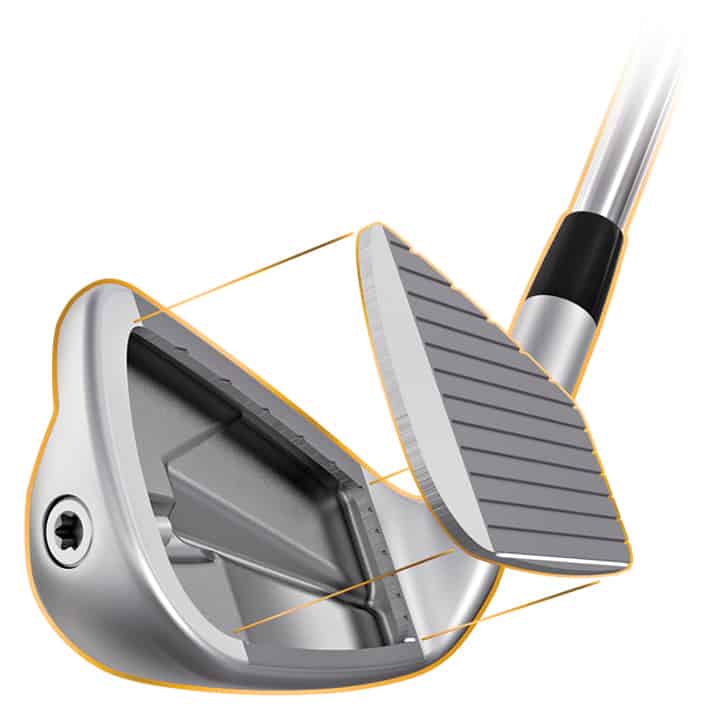
Many of these have made the game easier and where possible and affordable every golfer should take advantage of these.
For example ‘cavity back irons’ and ‘hybrid clubs’, are specifically designed to be more forgiving and therefore make it easier for players to hit shots.
Forged blade irons, by comparison, require a player of a certain skill level to play them well so if you are a high handicap player using these chances are you will be losing distance and accuracy.
So if you are not checking your clubs are at least comparatively up to date chances are you are leaving strokes on the course and missing out on opportunities to make your golfing life that little bit easier.
Get Into the Grooves of Your Wedges Specifically
Golfers with a handicap of more than 10 will hit less than 7 out of 18 greens in regulation on average and your average golfer with a handicap in the mid-teens will hit even less.
That inevitably means a lot of shots from 100 yards in for the typical weekend golfer – approximately 60% in total – and as a result the clubs in the bag which will get the most use are the wedges.
And given how versatile wedges are and the number of shots they can be used for – recovery shots from paths, bunkers etc – it is likely your wedges will wear out faster than many of the other clubs you carry.
The problem with this is wedge wear and tear is the enemy of spin and therefore control of your wedge shots.
Again we are not advocating people rush out and spend hundreds of dollars, pounds or euros changing their wedges just so they can get more spin on the golf ball.

But if you playing regularly and looking for ways to improve your game it is probably worth taking a look at your wedges before any of your other clubs.
You may find the grooves are worn down and therefore starting to affect how much control you can get with your wedge shots.
Be Exact with Your Own Golf Stats
If you are keen to improve your game you need to know what the weaker areas of your game are so that you can quickly focus on addressing them.
To do that a rough recollection of how you think you played during your last round and a general idea of how far you hit each club is not good enough.
You need to be clear on what you need to focus any practice sessions on and know how far you hit every club in your bag to help you decide on the right club on the course.
Thankfully technology again makes these things easier now.

There are lots of golfing apps, many of them free, which will let you simply track your high-level stats and quickly identify what are the weakest parts of your game that you need to work on.
Similarly, it is a straight forward process to measure golf shot distance these days with multiple tools available to make this task even easier.
While it is always tempting to hit lots of shots at the range that we are good at if your stats are telling you are getting up and down less than 10% of the time then there’s going to be little gained from not starting some hard work on your short game.
Similarly, if you are faced with a 145 yard shot it surely would help to know which iron in your bag you most consistently hit that distance?
Better players analyse their game so any practice they do is specific to addressing their specific weaknesses and prepare as far as possible to take any guesswork out of picking what club they should play.
Your stats won’t lie and tracking them consistently will give you a consistent feedback loop to help direct your practice over the coming weeks and months.
Always Practice With a Specific Goal in Mind – Be SMART
Now that you are tracking your stats and are clear on what specific areas of your game need to be addressed to make improvements a vital next step is to add a specific goal to your practice.
And make these goals SMART where you can – Specific, Measurable, Achievable, Realistic, Timely.
If you are a high handicapper, is it realistic for example to set yourself golf of becoming a scratch golfer within a few months?
SMART goals will by comparison give you something that you can sensibly aim to achieve and track your progress against as time passes.
It is amazing how many golfers will complain that they are not getting any better and when you ask them what their target handicap or score is for the next couple of months they won’t have any number in mind.
Or they will have such an unrealistic goal in mind that they are quickly getting discouraged.
If you don’t set a sensible destination it is impossible to plot a map route to get there.
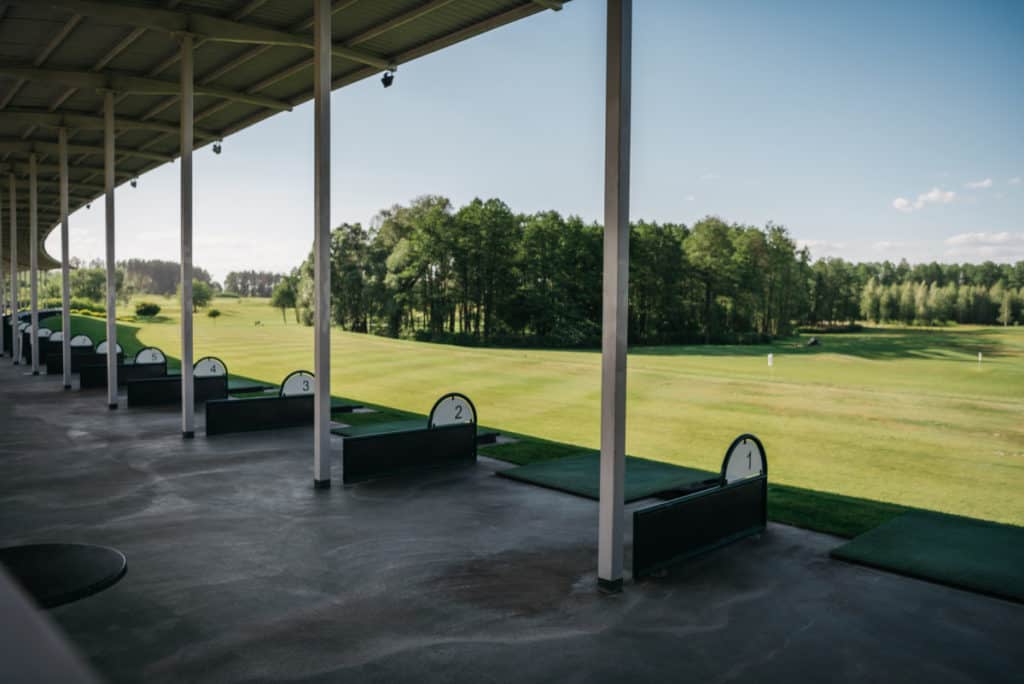
Practice in a Purposeful Way
We’ve all done it. You pitch up at the range, grab a bucket of 50 or 100 balls and start hitting away without another thought.
Before long 15-20 minutes has gone by, you have hit about 30 balls with a variety of different clubs and hardly paid much attention to what you are doing.
To consistently hit better golf shots and improve your game you need to follow a deliberate method.
Having identified through your stats that the weakest part of your game is your pitching and putting what is the point of rocking up to the range and crashing a bunch of drivers into the distance.
Or to get to the pitching and putting green without any real plan of what types of pitches and putts you are going to practice.
Repeating and practising an activity over and over again is unquestionably the correct route to targeting improvement.
But if you are practising the wrong activity in the wrong way it may have no effect on performance or worse still lead to the adoption of a bad habit which will make future performance improvement even harder.
So consider carefully what type of practice you are planning for your next session.
If shots under 100 yards are your problem consider splitting up your 50 balls into groups of 10, and then hit one group at the 100-yard marker, the next 90 yards, then 80 yards and so on until your finished.
Keep using the same club and improve your feel of how to adjust your distance control as you get closer to the green.
Or try replicating the shots you hit at the 2 or 3 holes on your course that give you the most trouble.
Play them on the range exactly as you would like to on the course.
If it’s a long par 5 that’s your nemesis hit your driver, then the fairway wood, hybrid or long iron you would typically play next and then a wedge shot.
Practice is key but if it is not purposeful you run the risk of adding even more bad habits to your game.
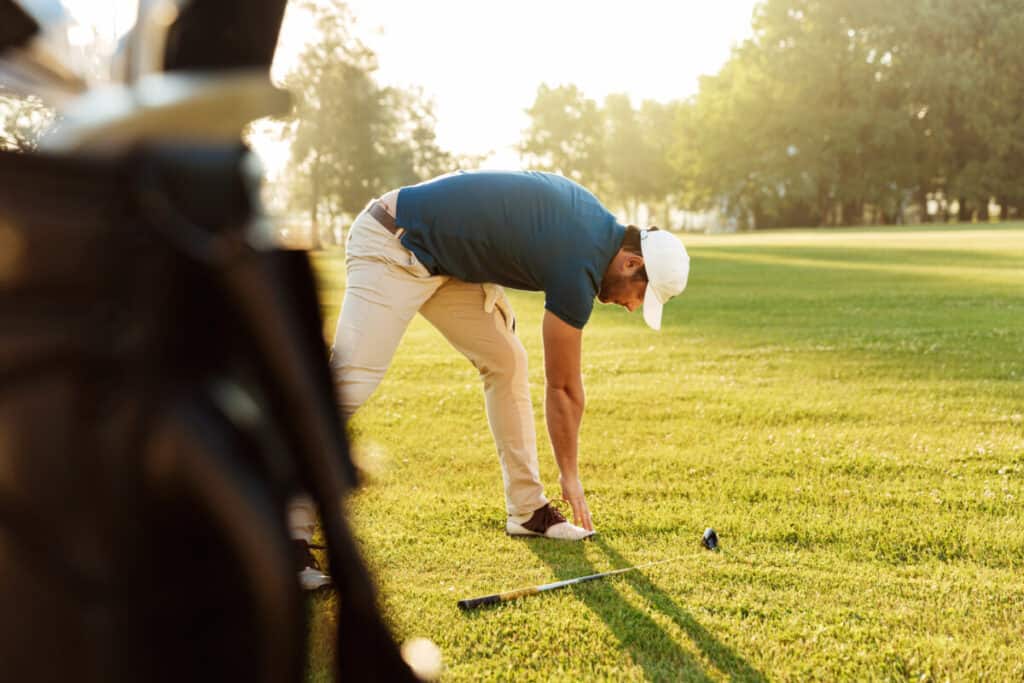
Make Sure Your Warm-Up Targets the Hips, Glutes & Neck
In an ideal world before every round we would all arrive at the course an hour or so before we are due to tee off to enable us to get a good warm-up.
Unfortunately, normal busy lives don’t make that easy and often golfers will be rushing to put their golf shoes in time to get to the first tee in time for their game, grab their driver, and tee off following one or two brief practice swings.
Rarely however on these occasions will the ball soar off straight into the distance up the middle of the fairway and despite every golfer being aware they should warm up it is amazing to find how many don’t or are unable to.
Better players, however will always make time to warm up and typically will hit some practice shots before they reach the first tee to give themselves a better chance of playing well.
If time is tight however every golfer should be able to find at least 5 or 10 minutes before they play a round or practice to at the very least warm up the main muscles they are going to use when playing.
Any warm-up routine should focus on the hips, glutes and neck / upper spine particularly to make sure they are prepared in some small way for making a series of golf swings.
The golf swing is an unnatural and complex series of muscle movements that need to be combined together and timed well repeatedly so it is important that you don’t take your body by surprise straight away with a big lunge with the driver on the first tee.
Whatever warm-up time you have before you play or practise should focus on the key muscles you will be using repeatedly so establish a minimum warm-up routine which you can run through by default.
Nail Down Your Pre-Shot Routine and Stick to It
Process goals are very powerful and they are one of the few things on a golf course you are in total control of every time you hit a golf ball.
One such process goal is your pre-shot routine and it is one thing you should have in the bank and deliver before you strike every golf shot you play.
A good process goal for your pre-shot routine might be to make 2-3 practice swing humming your favourite song before every golf shot.
Or it might be standing beside the ball and imagining hitting the exact shot you plan to before then trying to do so.
Pre-shot routines become even more important when the pressure is on and if you’ve got one you trust the likelihood is that you will have a better chance of hitting the shot you want.
6 time Major Champion, Sir Nick Faldo, was famous for his meticulous preparation, particularly in the build-up to major championships and is a big exponent of a pre-shot routine which involves hitting an imaginary ball at full speed.
As he puts it “….the mind does not know the difference between a rehearsal and the real thing”.
Work On Your Alignment
When you hit a golf ball your head and body is not facing the target where you are aiming.
To not be looking where you are going, and indeed facing in a different direction is counterintuitive, and beginners in particular, can find it difficult to make sure there are aligned correctly.
The good news is alignment is something you can work on easily and consistently.
You can use golf alignment sticks, or to be honest just another two of your own clubs, to check your alignment when your practising to help you improve on it.
Place one stick above your feet and the other above the ball and using the sticks as a guide ensure your arms, feet and eyes are parallel to the left of your target.
Golfers of whatever standard will always be checking and working on their alignment so if you can find a process step or trick that you can add to your pre-shot routine to ensure you are well aligned before you hit each shot even better.
You can’t use other clubs or alignment sticks on the course during the round though of course!
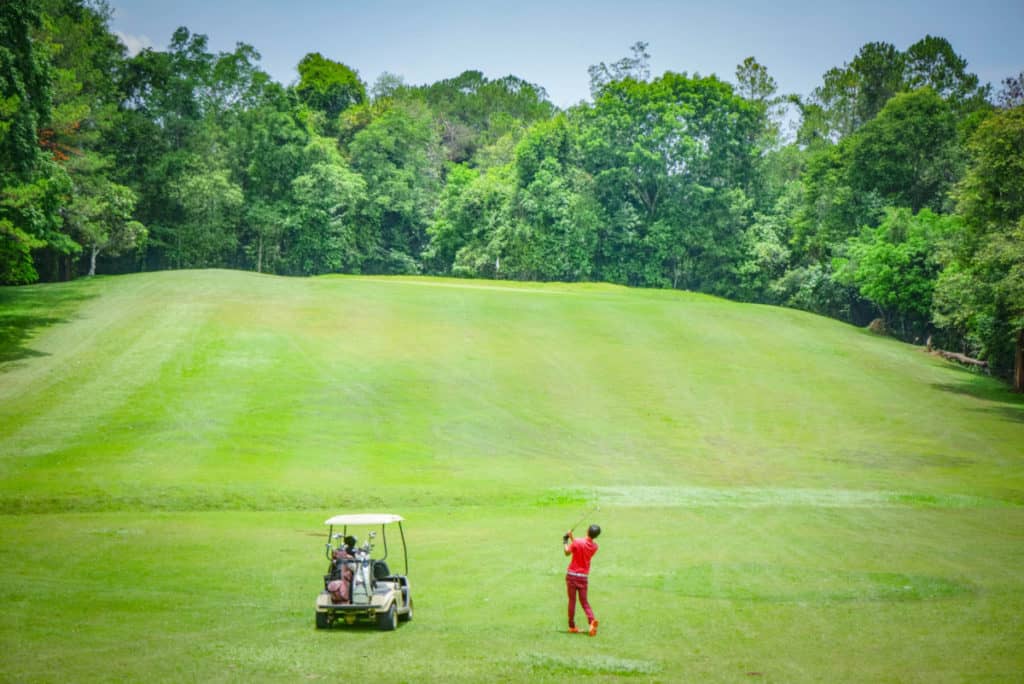
Focus on Your LONG Game More Than Anything Else
If I had a dollar for every time someone told me that if I really wanted to improve my scores I should focus almost exclusively on practising my short game I would be a rich man.
After all, it makes sense doesn’t it?
Given that at least 50% of your shots will be from 100 yards in whatever standard of player you are surely you should therefore be spending the vast majority of your practice time on your short irons, chipping and putting.
But the reality is the stats today show that it is a myth that your short game is the key to better scores.
If you are really serious about getting better and finally breaking 100, 90, 80 or even 70 it is the long game that is more important.
According to Mark Broadie, Columbia Business School professor, author of ‘Every Shot Counts’ (Check here to see my review of Professor Broadie’s great book) and pioneer of the ‘strokes gained’ metrics first adopted by the PGA Tour in 2011 chipping and putting (the short game) explains only one-third of the difference in scores between two typical amateur golfers.
The long game (i.e. driving and approach shots) explains two-thirds of the difference.
In other words, 66% of the difference in the score of a player shooting 80 and one shooting 100 comes from skill differences in driving and approach shots.
For clarity, an ‘approach shot is a shot that starts outside of 100 yards from the hole, excluding tee shots on par-four and par-five holes.
A ‘short game’ shot by comparison starts within 100 yards of the hole excluding shots that start on the green (i.e. excluding putts).
Professor Broadie acknowledges his analysis goes against almost all of golf’s conventional wisdom and will be considered close to heresy by some.
He also does not deny that putting is of course a critical part of the game and that putts are likely to be the easiest strokes to erase from your scorecard.
But he is simply highlighting that the analysis of millions of golf shots disproves the conventional wisdom that the short game is key to all major golf improvements.
And when you look at Tiger Wood’s numbers it is hard to argue against it.
Broadie found that between 2004 and 2012 on the PGA Tour Tiger gained 2.79 strokes per round against the field’s average – close to 1 stroke better than the next best-ranked player.
And where did the biggest proportion of Tiger’s gain come from – approach shots – a whopping 46% (1.28 strokes out of 2.79) of his gain against the field!
“Guys say you have to have a short game to win tournaments and it is not the case. Not at all” (Rory McIlroy)
“I agree with Rory. I never practiced my short game because I felt like if I can hit 15 greens a round and hit a couple of par fives in two and if I can make all my putts inside 10 feet, who cares where I chip it?” (Jack Nicklaus)
Source: Every Shot Counts (Check out latest price on Amazon)
Ask the Mirror on the Wall for Feedback
Even if you don’t take any lessons you are going to need to get some feedback at some point.
And a mirror in which you can see your whole body is a great tool for this.
When you are swinging a golf club you will inevitably make mistakes.
Repeatedly putting together the complex series of movements that comprise the golf swing correctly on a consistent basis is difficult.
The margins for error are small.
And as you can’t see your own swing it is difficult to know what mistakes you have made and without knowing your mistakes it is impossible to know how you can rectify them.
A mirror is a great tool to help with this.
You will get instant feedback on whether you are swinging correctly and be able to quickly identify any mistakes you may be repeating.
Practising any swing changes consistently in front of a mirror is, therefore, a great way to help golfers improve their technique and commit those improvements to the muscle memory bank.
Many driving ranges will have booths with mirrors behind them which you can use and there are also some very handy portable golf mirrors you can take with you anywhere to let you keep an eye on your swing yourself.
Record Your Swing and Use Training Aids to Identify Issues
As we have noted you need feedback in order to help you see what needs to be improved.
A golf instructor is one way to get this but if you are not taking lessons golf training aids and swing analysers can be an excellent cost-effective way to gather that all-important feedback on your strengths and weaknesses.
It is hard to know what you are doing wrong sometimes and as with clubs technology has come to the fore in recent years enabling the development of multiple tools to help players analyse their game.
“Feedback is the greatest teacher there is. You look at the ball and see what it did, and if you know your swing and your mechanics, you know what you need to do to fix it”
6 time Major Champion, Lee Trevino – Wall Street Journal (Top Pros Who’ve Never Had a Lesson)
Swing analysers today can show your key swing metrics such as swing speed, tempo, swing plain, club face angle and so on to help you identify where things may be going wrong.
And some of them can even let you set swing goals and therefore let you see how each individual swing compares to those goals which can be a great help in any quest to implement a swing change.
Others meanwhile act as both a warm-up tool and training aid and focus on key swing movements, timing and rhythm.
So the great news is today there are a huge amount of tools and aids which can give you that all-important feedback on your swing.
Practice One-armed Swings to Improve Consistency
The golf swing is a un-natural series of complex movements that need to be combined together and timed well multiple times throughout a round.
There is little margin for error in the golf swing so to complete it consistently well is the challenge for all golfers.
An inconsistent golf swing delivers poor golf.
Practising one-armed swings is one effective way to help create consistency in your golf swing.
If you are right-handed the left side of your body helps you to control most of your swing.
You are aiming to let your left side rather than your right to ‘pull’ the golf club in the downswing so have a go at practising one-armed golf swings for a week.
You may be surprised by your performance when you put both hands back on the club.
Vary Your Practice to Keep Things Fun
When kids are introduced to playing golf a lot of effort is made to help them not get bored when they pick up the game.
Parents and golf clubs will look at a myriad of ways to introduce kids to the game – miniature golf, video games, games in the back garden/backyard, made up games on the golf course – all with the intent to make sure they have fun and enjoy the game as much as possible.
So why this should goal to maintain the fun be any different for more experienced players.
If you are looking to improve you are going to have to put in a decent amount of practice.
It’s not going to come any other way unfortunately but that does not mean your practice sessions always have to involve simply hitting dozen after dozen of golf balls on the practice range.
Mix things up to keep your practice sessions engaging and interesting. Practice at home, practice at the range, play different types of games on the course with your buddies.
You can be working on a specific change or shot at any point in multiple varieties of ways and that can be important to do to maintain focus and keep you on target to your improvement goals.
Remember the main goal is always to enjoy the game and have some fun and just because you are potentially putting in some extra practice doesn’t mean you can’t add a bit of fun to that as well.
[Note – Just so you know, and we are upfront as an affiliate program participant, Golfing Focus, at no cost to you, earns from qualifying purchases made through links on this page.]
Other top articles related to this topic
- Are Putting Lessons Worth It? We Surveyed Over 100 Golfers
- Will Putting Practice on Your Carpet at Home Burn Your Scores?
- Is Hitting Golf Balls Into a Net Good Practice? Feel is Key!
- What Hybrids Should I Carry? It’s All About Ego
- Should I Play Blades or Cavity Back Irons? Use Your Head
- 5 Top Tips to Beat a Better Golfer
- 10 Ways to Lower Your Handicap Fast. No Swing Changes Needed!
- 10 Best Golf Stats to Keep Track of. Start with ‘Major Mistaks’
- Why Do I Get Worse the More I Play? You Need Some SPICE!
- 5 Step Golf Warm-Up Routine Without Going to the Driving Range
- How Much Does a Golf Club Fitting Cost? Is it Worth it?
RECENT ARTICLES
LEGAL INFORMATION
This site is owned and operated by Golfing Focus Limited, a private limited company whose registered office is in London, UK. Golfing Focus Limited is a participant in the Amazon Services LLC Associates Program, an affiliate advertising program designed to provide a means for sites to earn advertising fees (at no cost to you) by linking to Amazon.com. Golfing Focus Limited also participates in other affiliate programs with the eBay Partner Network, FlexOffers, CJ.com, Svorn and other sites and is compensated for referring traffic and business to these companies (again at no cost to you).
Our Socials






Leave a Reply